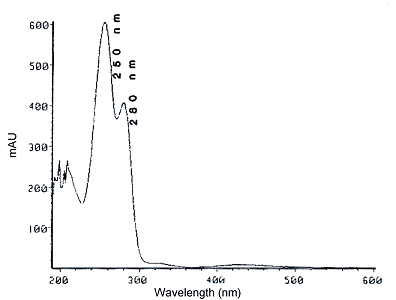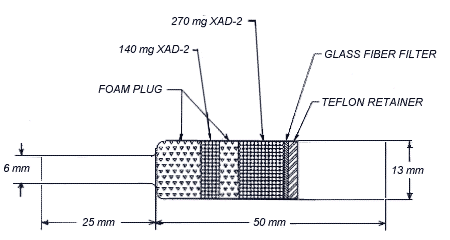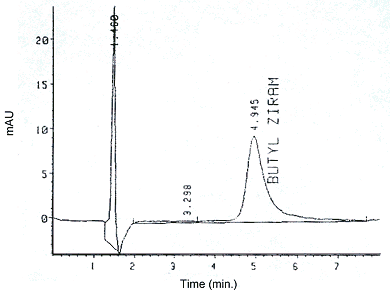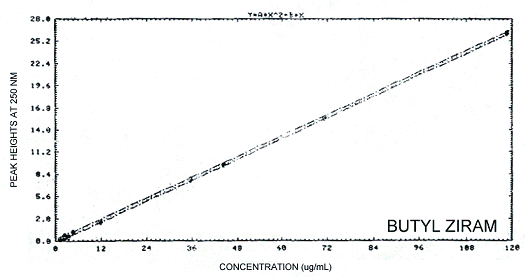BUTYL ZIRAM
| Method number: | PV2065 |
| Matrix: | Air |
| Target Concentration: | 0.4 mg/m3 (arbitrary). There is no OSHA permissible exposure level (PEL) or ACGIH threshold limit value (TLV) for butyl ziram. |
| Procedure: | Samples are collected by drawing known volumes of air through
OSHA versatile sampler |
| Recommended air volume and sampling rate: |
180 L at 1.0 L/min |
| Detection limit of the overall procedure (based on the recommended air volume and the analytical detection limit): | 0.026 mg/m3 |
| Status of method: | Stopgap method. This method has been partially evaluated and is presented for information and trial use only. |
| Date: June 1989 (final) | Chemist: Duane Lee |
Carcinogen and Pesticide Branch
OSHA Analytical
Laboratory
Salt Lake City, Utah 84115-1802
1. General Discussion
1.1. Background
1.1.1. History of procedure
The OSHA Analytical Laboratory received a set of samples
requesting the analysis of butyl ziram. The samples had been
collected on
1.1.2 Toxic effects (This section is for information only and should not be taken as the basis of OSHA policy.)
From tumorigenic data on mice, the oral TDLo and the subcutaneous TDLo are 290 gm/kg/78W-1 and 1000 mg/kg respectively. These levels produce tumors in the lungs, thorax, liver and blood. (Ref. 5.2)
1.1.3 Potential workplace exposure
Butyl ziram is used as an accelerator for latex dispersions and
cements as well as an
1.1.4 Physical properties (Ref.5.1
- 5.2)
| CAS number: | 136-23-2 |
| IMIS number: | D129 |
| Molecular weight: | 476.19 |
| Molecular formula: | C18H36N2S4Zn |
| Melting point: | 104-108°C |
| Specific gravity: | 1.24 (20/20°C) |
| Solubility: | soluble in carbon disulfide, benzene and chloroform; insoluble in water |
| Chemical name: | Bis(dibutyldithiocarbamato)zinc |
| Synonyms: | Zinc dibutyldithiocarbamate; Butazate; Carbamic acid,
dibutyldithio-, zinc complex; Butyl ziram; Zinc
|
| Description: | white powder |
| UV Scan: | Figure 1. |
| Structure: |  |
1.2 Limit defining parameters
The detection limit of the analytical procedure is 4.7 ng per injection. This is the amount of analyte which will give a peak whose height is approximately five times the baseline noise.
2. Sampling Procedure
2.1 Apparatus
2.1.1 A personal sampling pump that can be calibrated to within ±5% of the recommended flow rate with the sampling device in line.
2.1.2
2.2 Reagents
No sampling reagents are required.
2.3 Sampling technique
2.3.1 Immediately before sampling, remove the plastic caps from
the
2.3.2 Attach the small end of the tube to the sampling pump with flexible tubing.
2.3.3 Attach the tube vertically in the employee's breathing zone in such a manner that it does not impede work performance.
2.3.4 After sampling for the appropriate time, remove the tube and seal with plastic caps.
2.3.5 Wrap each sample
2.3.6 Record the air volume for each sample, and list any possible interferences.
2.3.7 Submit at least one blank for each set of samples. Handle the blank in the same manner as the samples, except no air is drawn through it.
2.3.8 Submit bulk samples for analysis in a separate container. Do not ship with air samples.
2.4 Desorption efficiency (glass fiber filter and
Six vials each containing a
|
| |||
| Sample # | Amount Spiked, µg |
Amount Found, µg |
% Recovered |
|
| |||
| Ex;1 Ex2 Ex3 Ex4 Ex5 Ex6 |
71.25 71.25 71.25 71.25 71.25 71.25 |
71.44 70.53 71.61 72.02 71.21 72.04 |
100.3 99.0 100.5 101.1 99.9 101.1 |
| Average | 100.3 | ||
|
| |||
2.5 Retention efficiency
Eighteen
|
| |||
| Sample # | Amount Spiked, µg |
Amount Found, µg |
% Recovered |
|
| |||
| Ex1 Ex2 Ex3 Ex4 Ex5 Ex6 |
71.25 71.25 71.25 71.25 71.25 71.25 |
70.12 69.99 66.35 65.79 69.10 67.35 |
98.4 98.2 93.1 92.3 97.0 94.5 |
| Average | 95.6 | ||
|
| |||
2.6 Sample storage
After nine days of storage, the 12 tubes were each desorbed with
2.0 mL of chloroform, shaken for 30 min and then analyzed as in
Section 3. The results are given in Tables 2.6.1 and 2.6.2.
|
| |||
| Days Stored |
Amount Spiked, µg |
Amount Found, µg |
% Recovered |
|
| |||
| 9 9 9 9 9 9 |
71.25 71.25 71.25 71.25 71.25 71.25 |
65.69 60.77 62.07 58.70 60.26 62.89 |
92.2 85.3 87.1 82.4 84.6 88.3 |
| Average | 86.7 | ||
|
| |||
|
| |||
| Sample # | Amount Spiked, µg |
Amount Found, µg |
% Recovered |
|
| |||
| 9 9 9 9 9 9 |
71.25 71.25 71.25 71.25 71.25 71.25 |
63.85 58.00 66.25 60.98 63.06 62.21 |
89.6 81.4 93.0 85.6 88.5 87.3 |
| Average | 87.6 | ||
|
| |||
2.7 Recommended air volume and sampling rate
2.7.1 The recommended air volume is 180 L.
2.7.2 The recommended flow rate is 1.0 L/min.
2.8 Interferences (sampling)
It is not known if any compounds will interfere with the collection of butyl ziram. Any suspected interferences should be reported to the laboratory.
2.9 Safety precautions (sampling)
2.9.1 Attach the sampling equipment in such a manner that it will not interfere with work performance or employee safety.
2.9.2 Follow all safety practices that apply to the work area being sampled.
3. Analytical Procedure
3.1 Apparatus
3.1.1 A balance capable of weighing to the nearest tenth of a milligram. A Mettler HL52 balance was used in this evaluation.
3.1.2 A mechanical shaker.
3.1.3 An HPLC equipped with a UV detector. A Hewlett Packard (HP) 1090M equipped with an autosampler and diode array detector was used in this evaluation.
3.1.4 An HPLC column capable of separating butyl ziram from any interferences. A 50 mm × 4.6 mm i.d. ECON C8 (3 µm) liquid chromatography column was used in this evaluation.
3.1.5 An electronic integrator, or some other suitable means for
measuring detector response. The
3.1.6 Volumetric flasks and pipets.
3.1.7 Vials,
3.2 Reagents
3.2.1 Chloroform, reagent grade. This was obtained from Burdick and Jackson for this evaluation.
3.2.2 Butyl ziram, reagent grade. A standard obtained from H.M. Royal Incorporated was used in this evaluation.
3.2.3 Methanol, HPLC grade. This was obtained from Burdick and Jackson for this evaluation.
3.2.4 Water, HPLC grade,
3.2.5 Zinc sulfate heptahydrate (ZnSO4 · 7H2O) reagent grade. This was obtained from Mallinckrodt for this evaluation.
3.2.6 4-Dodecyldiethylenetriamine, reagent grade. This was obtained from Eastman Kodak for this evaluation.
3.2.7 Ammonium acetate, HPLC grade. This was obtained from Fisher Scientific for this evaluation.
3.2.8 Zinc chelate (10 mM) of the
C12-dien-Zn (II) metal chelate. This was
prepared by placing 2.71 grams of
3.3 Standard preparation
Prepare butyl ziram stock standards by weighing 10 to 15 mg of
butyl ziram. Transfer the butyl ziram to separate
3.4 Sample preparation
3.4.1 Transfer the
3.4.2 Add 2.0 mL of chloroform to each vial and seal with a
3.4.3 Shake the vials for 30 minutes on a mechanical shaker.
3.4.4 Transfer, if necessary, the samples to
3.5 Analysis
3.5.1 Instrument conditions
| Column: | 50 mm × 4.6 mm ECON C8 (3 µm) |
| Mobile phase: | 86% methanol 14% water with 1 mM zinc chelate and 0.13 M ammonium acetate (Ref. 5.3) |
| Flow rate: | 0.5 mL/min |
| Wavelength: | 250 nm |
| Retention time: | 5.1 min |
| Injection volume: | 2.0 µL |
3.5.2 Chromatogram (Figure 3.)
3.6 Interferences (analytical)
3.6.1 Any collected compound having a similar retention time to that of the analyte is a potential interference.
3.6.2 HPLC conditions may generally be varied to circumvent interferences.
3.6.3 Retention time on a single column is not proof of chemical identity. Analysis on an alternate HPLC column and confirmation by mass spectrometry are additional means of identification.
3.7 Calculations
3.7.1 Construct a calibration curve (Figure 4.) by plotting detector response versus concentration (µg/mL) of butyl ziram.
3.7.2 Determine the µg/mL of butyl ziram in both sections of each sample and blank from the calibration curve.
3.7.3 Blank correct each sample section by subtracting the g/mL found in the blank section from the µg/mL found in the corresponding sample section and then add the sample sections together.
3.7.4 Determine the air concentration by using the following formula.
| mg
m3 |
= | (µg / mL)(desorption volume, mL)
(air volume, L)(desorption efficiency, decimal) |
3.8 Safety precautions (analytical)
3.8.1 Avoid skin contact and air exposure to butyl ziram.
3.8.2 Avoid skin contact with all solvents.
3.8.3 Wear safety glasses at all times.
4. Recommendation for Further Study
This method should be fully validated.

Figure
1.
UV Scan of Butyl Ziram in Mobile Phase

Figure
2.
OVS-2 Sampling Tube

Figure
3.
Chromatogram of Butyl Ziram

Figure
4.
Calibration Curve
5. References
5.1 The Condensed Chemical Dictionary 9th ed.; Hawley, G.G. Ed.; Van Nostrand Reinhold: New York, 1977; p 938.
5.2 Registry of Toxic Effects of Chemical
Substances 1985-86 Edition; DHHS(NIOSH) Publication No.
5.3 Karger, B.L.; Wong, W.S.; Viavattene, R.L.;
Lepage, J.N.; Davies, G. Journal of Chromatography 1968, 167,